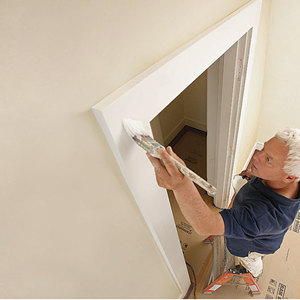
There was a time when I thought that success was measured by making a lot of money, so I became a spec builder. I partnered up with a former boss who had made a lot of money in that business before, and we went to town. One lesson I learned from that time was how to build houses that would sell for as much money per square foot as possible while costing as little to build per square foot as possible. The market is capped at a certain price, and every dollar we spent that didn’t raise the value of the home by its cost plus our gross profit literally came out of our own pockets.
The other lesson I learned from that time is that money is only one way to measure the value of work. Spec building was a soul-sucking experience for me, but the lessons abide.
America’s homes are built on spec
Three quarters of American homes are built on spec . And every spec builder faces the same reality that I did—if you add a that feature doesn’t pay, you just bought that feature for the future homeowner. That’s an expensive hobby.
It comes down to what buyers want and appraisers value. I wanted to build more energy efficient houses, but when it came to green building, it seems buyers and appraisers have only a vague idea of the worth. In the hierarchy of desirable features that raise the selling price of a home, energy upgrades are right up there with such mundanities as the absence of asbestos or a new roof. Sources say that even recognized programs such as Energy Star only boost the value of a home by 1% to 3%. New paint is probably at least as important to…
Weekly Newsletter
Get building science and energy efficiency advice, plus special offers, in your inbox.

This article is only available to GBA Prime Members
Sign up for a free trial and get instant access to this article as well as GBA’s complete library of premium articles and construction details.
Start Free TrialAlready a member? Log in















7 Comments
I was asked by a couple client to help them find a “green” builder, because as they say, I have a curse to find wrongdoings on jobsites within 5 minutes… so we went to tour both's so called green builder’s jobsites. After seeing horrible issues. my questions to both "green builders":
• Have you certified a home to a green program? NO
• What’s your typical ACH50? Their answer: Say what?
• What’s your typical HERS score? Their answer: “what you talkin’ about Willis”
• Do you use rainscreens? Their answer: No, but we have pest control people we can call.
• Have you installed any outsulation? Their answer: Is that related to insulation?
• Have you heard of heel framing or heel trusses? Their answer: No.
• So what makes your house “green”? Their answer: We use OSB, Tyvek, healthy paints and other green products.
The reality is that not only builders need to know what green building is, but know how to build “green”, and more importantly, HOW TO SELL green building. See marketing campaigns by Nike, Apple, Coke, Volvo, VW, Google, Got Milk?, Where’s the beef?
Pre 2007 AD, a cell phone cost $20-$50, then some dude (Steve Jobs) came up with this crazy idea that THE ENTIRE WORLD NEEDS HIS $500-$600 iPhone so we can live a happy life… remember those days? And now, some of those iPhones are $1,100. Somehow Mr. Jobs knew how to sell his products, as Mr. Knight sold his $300 sneakers, and a 1964 VW Beetle cost $1,500 then.
HOW TO SELL… when builders start getting educated, not only on how to build green homes, but how to sell their green homes, the market will change, and the builders will help themselves to more sales.
If the list of things that defines a Green Building is going to include the disparate demands of healthy building, energy efficiency, reducing carbon emissions, and embodied energy, it's almost impossible to successfully market that green house to all but a tiny segment of the clients who buy spec homes.. It's one thing to show potential customers that the house will provide a clean, comfortable indoor environment and cost less to heat and cool, it's a completely different proposition to appeal on moral grounds the they should forgo a concrete slab to "save the planet". I'm not saying it might not be the right thing to do, just pointing out the difficulties of lumping the two aims under one label, and trying to find buyers.
Great article. Do you feel that mandatory energy scores being pushed by some states may be a real and perhaps the only driver beyond code? Even for the “woke millenials” like me, that information isn’t available when building “custom” trac homes, even if they were among the few that know what rvalues are. Air tightness isn’t one of the 3 upgrade options you are given.
We live in rarified air. Until the market demands green houses, we're going to get what we get.
As the Kinks so eloquently sang, "I'm Not Like Everybody Else". Building better is the opportunity for the small scale builder to distinguish him or herself. Impossible to compete with the production builder on price so look for a different market. Individual service is almost unheard of in the building business today, offer it along with the highest quality and see what happens. As I like to say, my customers make it easy for me as far as their expectation, they all expect perfection and I try to deliver.
As CarsonB indicates "mandatory energy scores" and codes may be the real driver. At the end of the day, most homes are built to code minimums (excepting the marble counters that are de rigueur in upscale homes). But the code minimums are why we also have homes with floor joists of adequate size, and plumbing pipe of correct materials, and electrical systems that are grounded safely. So if code minimums move enough in a green direction, we will have green enough buildings. At a time when clean emissions standards and auto gas mileage requirements are being loosened, that's probably fanciful thinking, but one day we may have leaders and legislatures that care for the good of the people and the planet.
I bought my first code book in the mid 80’s, a blue UBC binder, and my first IRC and IECC books were from 2000. I remember back in the 90s where anyone interested, studying or practicing energy efficiency was the enemy. Does being called wacko hippie, tree-hugger, spotted owl lover applies to you? Join the club.
In the mid 80’s, not too many of us had ever heard about Building Science, Psychrometric Charts, Rain Screens, IAQ and Make-Up Air, Blower Door Test, HERS and so on, so for some of us, today’s codes are a walk in the park, and it feels like all the education, volunteering, meetings, arguments, travel, conventions and summer camps have paid off in a big way. Those words are on most industry professionals today, and for the most part, the codes have improve tremendously the quality of construction for most of the country.
The Codes have expanded adoption, improved design parameters, developed mandatory fenestration, insulation, air leakage and sealing requirements, HVAC system improvements, MUA and ventilation, and best of all, verification. Green and Energy Efficient programs and standards were developed, and even though I believe most Builders used them as a “marketing gimmick”, they have become part of the conversation. So yes, a “code house” is the minimum legal house built, but the code changes have made a huge difference in the last 30+ years. If only the latest codes were to be applied nationally, without exceptions.
At the end of the day, it is up to each of us in the industry to increase our education and best practices, as well as to accept responsibility, pride and honesty for the work we do, without having to prove our worth or depending on someone to look over our shoulders.
Log in or become a member to post a comment.
Sign up Log in